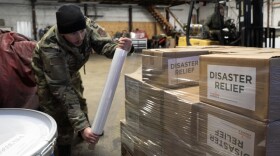-
Some work on critical infrastructure projects will continue, but the state’s focus will transition to supporting storm-impacted communities and evacuated residents through the winter, officials said.
-
From volunteer-powered efforts to provide essential items, to the massive, multi-agency push to shore up village infrastructure, Bethel shows what a regional hub can do in crisis.
-
Kelly Loeffler, head of the Small Business Administration, said the agency is modifying its rules to allow loans for damages to personal property at subsistence camps.
-
Many of the Western Alaskan residents displaced by Typhoon Halong also lost their subsistence harvests.
-
The state says it expects to move the roughly 300 people staying at the Alaska Airlines Center and Egan Center into hotel rooms by the end of the week.
-
The Kuskokwim Delta community evacuated dozens of residents and welcomed in dozens from nearby coastal villages hit hardest by the storm. As cold weather arrives, many still don't know if their homes will be livable again.
-
During the storm, wind speeds on the island reached 100 miles per hour and caused massive flooding of low-lying areas, floating homes off their foundations in Nightmute and destroying the subsistence site known as Umkumiut.
-
As residents boarded air transports out of Kipnuk, they left what remained of their houses, belongings, and ancestral homeland behind. For many, that list also included their dogs. Nonprofits and individuals have stepped in to reunite pets with displaced families.
-
Alaska Federation of Natives delegates passed 42 resolutions on Oct, 18, including a call for more federal help for Western Alaska and protections for subsistence practices.
-
Hundreds have been evacuated in military helicopters and planes to Bethel and Anchorage. Now, state officials are assessing what it'll take to rebuild villages hit hard by the storm.

Play Live Radio
Next Up:
0:00
0:00
Available On Air Stations










